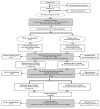Behavioral Interventions for Weight Management in Overweight and Obese Adolescents: A Comparison Between a Motivation-based Educational Program and Conventional Dietary Counseling
- PMID: 32308694
- PMCID: PMC7144245
- DOI: 10.5812/ijem.88192
Behavioral Interventions for Weight Management in Overweight and Obese Adolescents: A Comparison Between a Motivation-based Educational Program and Conventional Dietary Counseling
Abstract
Objectives: This study aimed to compare the effects of a three-month motivation-based educational program and conventional dietary counseling on body composition and relevant outcomes among overweight and Obese adolescents.
Methods: A total of 115 overweight and obese adolescents (46% boys) were randomly assigned to either a motivation-based program or a conventional dietary counseling. The assessments were conducted at baseline and 3, 6, and 12 months after intervention.
Results: Mean age and body mass index (BMI) Z-score were 14.5 ± 1.2 and 2.42 ± 0.62, respectively. Considering time trend analysis, the two groups achieved significant improvements in BMI Z-score, wrist and waist circumferences, body composition indices, and HRQoL total scores after a one-year follow-up. Wrist circumference and the HRQoL reported by parents revealed significant differences between the study groups in favor of the motivation-based program.
Conclusions: Although both programs could improve anthropometric indices and HRQoL over time, the motivation-based program was more effective in reducing adolescents' wrist circumference and improving HRQoL, as the parents reported.
Keywords: Adolescents; Behavioral Intervention; Motivation; Overweight and Obesity; Weight Management.
Copyright © 2020, International Journal of Endocrinology and Metabolism.
Conflict of interest statement
Conflict of Interests: The authors declare that they have no competing interest.
Figures
References
-
- Kelishadi R, Ardalan G, Qorbani M, Ataie-Jafari A, Bahreynian M, Taslimi M, et al. Methodology and early findings of the fourth survey of childhood and adolescence surveillance and prevention of adult non-communicable disease in Iran: The CASPIAN-IV study. Int J Prev Med. 2013;4(12):1451–60. - PMC - PubMed
-
- Knopfli BH, Radtke T, Lehmann M, Schatzle B, Eisenblatter J, Gachnang A, et al. Effects of a multidisciplinary inpatient intervention on body composition, aerobic fitness, and quality of life in severely obese girls and boys. J Adolesc Health. 2008;42(2):119–27. doi: 10.1016/j.jadohealth.2007.08.015. - DOI - PubMed
LinkOut - more resources
Full Text Sources

